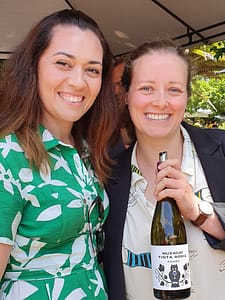Simplesmente… Vinho is an independent wine festival held annually in Porto. It’s for artisans and family businesses, for wines that respect terroir and tradition. As the organizers say, “sincere wines with a healthy dose of madness and poetry”.
Nowadays it’s held on the first weekend of July, in the open air of the gardens of the Casa Cor de Rosa of the Faculty of Architecture of Porto (FAUP). This tenth edition featured 101 vignerons from Portugal and Spain.
This year I tasted quite randomly in no special order. I will still try to categorize them for you. It is always a pleasure to taste the wines of producers like Tiago Sampaio, Antonio Madeira, Niepoort, Quinta de Carolina and Quinta do Infantado. However, here I will highlight some of the producers that I didn’t know that well. Yes, I knew about them and I had tasted some wines, but this was the first time I tasted their whole range. Three to watch were Quinta da Pôpa, Quinta da Poeta (both Douro) and Quinta do Escudial (Dão). There were also a couple of discoveries on a trip to the Vinho Verde region. These you can read about in a forthcoming article.
Muxagat was created in 2002 by the Almeida and Lopes families, in the village Muxagata of Douro Superior. Today Muxagat has its own winery in Mêda, where most of the grapes are sourced. It’s a minimal intervention project, also without addition of yeast. Susana Lopes and her family, with the help of Ana Silva, resident winemaker, and consultant Luis Seabra, make stylish, fresh wines in a region famous for heavier stuff.
I liked the whole range, from the fresh white wines (one of them an off-dry riesling), via the elegant light extracted rosé to the various shades of red. Here come a few of the best. Tinta Barroca 2021: Young colour with violet hints; mature dark and wild fruits (cherry, blackberry), flowers; luscious with fresh acidity – a serious glou-glou wine! The Tinta Francisca 2017 had more developed colour, an earthy, mineral aroma with red berries and white pepper, and a lightly structured palate. I also liked their regular Tinto 2017, a classic and complete red. Vale Cesteiros 2018, from older vines, is dark in colour with wild fruits (blackberry) and some balsamic; potent, still elegant, and with an integrated acidity. Cisne 2015 and 2016 were made from tinto cão 90% and rabigato, aged two years in wood. They showed some evolution, with earthy and fresh red fruits, then a powerful structure and a rich mouthfeel. The 2016 was the most powerful of the two.
Miguel Morais came to what is now Quinta da Costa do Pinhão, fell in love with it and knew he had to dedicate himself to the difficult task of working that land. Miguel says that 2014 was his first serious vintage. Over the years he has learned to understand the place better, respect the land, the plants, the animals, and cut on the chemicals, he says.
Quinta da Costa do Pinhão Branco 2019 was destemmed and fermented with skins in used barrels, and can be called an orange wine. Golden colour; mature apples, yellow fruits (tomatoes) and wet stone; rounded and balanced. The red Marufo 2019, from the rare grape of that name, was light, with currant colour; ripe raspberry fruit, spice; soft on the palate, balanced, and with a beginning evolution. The red with the company name was also of a classic style. Quinta da Costa do Pinhão Peladosa 2019 is a field-blend of 30 different varieties, a hundred years old vines on 1 hectare. Whole bunch pressing was carried out in a 500 litre barrel. Dark and wild fruits (blackcurrant, blackberry), menthol; concentrated flavours and delicate tannins.
There is nothing better than a little slowness in this era, says Rodrigo Martins of Espera (meaning: wait). He continues, we should give the wines time for maturation to deliver authentic and genuine aromas. He has 5 hectares of vineyards in Alcobaça, region of Lisboa, where the simple winemaking styles of the Cistercian monks is an inspiration. The idea is to be patient, and the ambition is to offer a unique quality product, at the same time unpretentious.
I really appreciate the elegant, low-extracted Atlantic style of this producer, and all wines could be highlighted. Here follow four of them. The Bical & Arinto 2020 from a young vineyard with low yield stayed 8 weeks in oak. It shows yellow fruit; is round, tasty, and concentrated. The Curtimenta 2021 stayed 17 days on skins. Light yellow, slightly cloudy; delicate skin-character (lemon peel); grapefruit in the aftertaste. The Espera Palhete 2021, a field-blend of some 20 varieties (70% white) was really delicate and delicious: Light red; raspberries; crisp acidity and a delicate texture. Espera NatCool 2021 is made for the Niepoort-distributed series of low-extracted natural wines in one-litre bottles. It’s made solely from castelão, is light red; with lots of red fruits (raspberry), a touch of flint; delicate, uplifting acidity.
Amoreira da Torre is one of the producers that manage to make fresh, varietal-scented wines from Alentejo, otherwise known for developed, jammy aromas. I tasted a few wines some years ago, and this was a good opportunity to re-discover. 20 hectares with Portuguese varieties from the region was planted in 2001 by Paulo Sendin and converted to organic four years later. The terroir at the estate in Montemor-o-Novo (on the highway to Évora) is characterized by granitic soils, abundant groundwater and a Mediterranean climate.
The Zebro line features some delicious, fruity wines of several colours at an un-beatable price. The microclimate is good for white wines, with water in the subsoil where roots go deep. Zebro Blanc de Noirs 2020, a varietal aragonêz, is made with very light pressing (“lágrima”), then immediate separation of the must. It’s quite unctuous, or broad, with anise and bitter almond notes; full and somewhat structured on the palate. Amoreira da Torre 2021 (aragonês, trincadeira, some cabernet sauvignon, 6 months in used oak) is youthful dark; fruity, dark and red fruits (morello, plums), green pepper, herbs and eucalyptus; rounded tannins, fresh and not overdone.
Look for next article from the Simplesmente fair, when there will be an update on producers already known on the blog.
2 Comments




